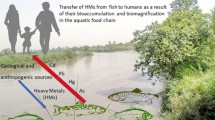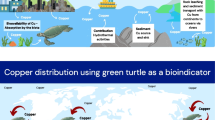Abstract
The spatial and seasonal variation of total and subcellular distribution of Cd, Cu, and Zn was followed in different tissues (gills, digestive gland, and remaining tissues) of the clam Ruditapes decussatus collected along a metal contamination gradient in the Ria Formosa lagoon (southern Portugal) and compared with metallothionein (MT) concentrations.
Total metal concentrations decreased according to the sequence digestive gland > gills > remaining tissues for Cd, digestive gland ≈ gills > remaining tissues for Cu and gills > digestive gland > remaining tissues for Zn. MT concentrations in these tissues decreased according to the same sequence observed for Cd. In all the tissues, the highest subcellular concentration was in the cytosol for Cd and Cu and in the pellet for Zn. Among the three metals, Cd concentrations showed the most evident spatial variation. In all tissues, total and subcellular Cd concentrations decreased from the inner parts of the lagoon toward the ocean. However, no significant spatial or seasonal variation occurred in clam tissues for the other two metals, though marginal elevated Cu concentrations were observed in the inner parts of the lagoon. Therefore, Cu subcellular distribution in clam tissues was not significantly altered by Cu changes in the lagoon and are the baseline levels for normal metabolism of this clam population. The fact that total Zn concentrations remained unchanged both spatial and seasonal suggested that these clams regulate Zn in their tissues.
In the three tissues, MT bind most significantly to Cd and Cu, while Zn, although binding to MT, is preferably bound to other ligands. MT concentrations showed the same spatial and seasonal variation of Cd and were significantly related with total and heat-treated cytosolic Cd in all tissues. For Cu a significant relationship between MT and total or cytosolic Cu was only observed in the remaining tissues. No relationship was observed between MT and total or cytosolic Zn concentrations. Metals and MT concentrations increased with the increase in the condition index for the gills and the digestive gland and decreased from the remaining tissues.
Cd concentrations in the gills increased only in the heat-treated cytosolic fraction while Zn in this fraction decreased. Thus Cd concentrations in this tissue displaced Zn from the MT-fraction, leading to a modification of the soluble/insoluble Zn ratio once total Zn concentrations remained unchanged. This modification reflects a perturbation in the normal metabolism in this tissue due to the excess of Cd present. With the exception of the gills, Zn subcellular distribution in the other two tissues was similar among sites and season.
The model that describes the relationship between MT, metals, and weight in the gills, digestive gland and remaining tissues also indicates that Cd was the only metal that influence MT synthesis significantly in all the tissues. The induced and/or existent MT was sufficient to bind free Cd ions present in the cells, preventing any damage to cellular metabolism in this clam population. Therefore, MT in the gills and digestive gland of R. decussatus can be used as an early warning signal for Cd exposure and are a useful biomarker to assess the toxicological status of this population in the Ria Formosa lagoon.
Similar content being viewed by others
Author information
Authors and Affiliations
Additional information
Received: 31 January 2002/Accepted: 29 July 2002
Rights and permissions
About this article
Cite this article
Bebianno, M., Serafim, M. Variation of Metal and Metallothionein Concentrations in a Natural Population of Ruditapes decussatus . Arch. Environ. Contam. Toxicol. 44, 0053–0066 (2003). https://doi.org/10.1007/s00244-002-2004-7
Issue Date:
DOI: https://doi.org/10.1007/s00244-002-2004-7




